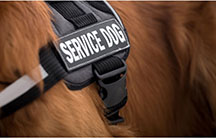Service Animals
 A request to bring a service or therapy animal to school may cause some unease and stimulate questions for school administrators and school nurse leaders. Schools must comply with disability discrimination laws, but also ensure students’ and staff health and safety. When planning for animals being brought into the school building, school leaders need to ensure the animal’s presence in the school environment is safe for both the animals and the students. Schools should also consider any potential allergies or sensitivities among students and staff when introducing animals into the learning environment.
A request to bring a service or therapy animal to school may cause some unease and stimulate questions for school administrators and school nurse leaders. Schools must comply with disability discrimination laws, but also ensure students’ and staff health and safety. When planning for animals being brought into the school building, school leaders need to ensure the animal’s presence in the school environment is safe for both the animals and the students. Schools should also consider any potential allergies or sensitivities among students and staff when introducing animals into the learning environment.
Both federal laws, Section 504 and ADA Title II, permit a student with a disability who uses a service animal who meets the ADA definition to have the animal at school. Students with service animals cannot be isolated from others, treated less favorably than others or charged fees not charged to others without animals.
Responsibilities of Schools
Schools are responsible for ensuring that students with disabilities who use service animals are not discriminated against and are provided equal opportunities to participate in all aspects of school life. This includes allowing the service animal to accompany the student to classes, extracurricular activities, and other school events.
Definition of Service Animals
According to the Americans with Disabilities Act (ADA) and Section 504 of the Rehabilitation Act, service animals are defined as dogs (and in some cases miniature horses) that are individually trained to perform tasks or work for people with disabilities. These tasks may include guiding individuals who are blind, alerting individuals who are deaf, pulling a wheelchair, alerting to the presence of allergens, alerting to medical concerns such as a seizure or diabetes symptoms, calming someone during an anxiety attack, or performing other specific tasks directly related to the person's disability.
In situations where it is not obvious that the dog is a service animal, school administrators and staff may ask only two specific questions:
- is the dog a service animal required because of a disability? and
- what work or task has the dog been trained to perform?
School administrators and staff are not allowed to request any documentation for the dog, require that the dog demonstrate its task, or inquire about the nature of the person’s disability.
Training and Certification
Service animals must be trained to perform specific tasks or work directly related to the individual's disability. However, there is no legal requirement for service animals to be professionally trained, certified, or registered. Schools cannot require proof of certification for a service animal as a condition of allowing the animal to accompany the student.
Health and Safety
Schools may establish reasonable rules to ensure the health and safety of all students and staff. However, they cannot exclude a service animal solely based on assumptions or fears about allergies, fear of animals, or the animal's breed. In this case, students should be accommodated by assigning them, when possible, to different locations within the room or different rooms in the same school.
ADA regulations state that the service animal is not permitted to stay at school if it is out of control; the animal’s handler does no take effective action to control it; or it is not housebroken.
The school district is not responsible for the care, including elimination and food needs of the service animal. The animal’s owner/family/handler is responsible of the “care and supervision of the service animal”.
ADA regulations state that if there is more than one service animal in a school building at a time, appropriate arrangements to socialize the animal must be made in a controlled environment before or after school hours.
Emotional Support and Therapy Animals
These terms are used to describe animals that provide comfort just by being with a person. “Emotional support” or “therapy” animals are treated differently under the ADA because these animals do not receive the same level of training, having not been trained to perform a specific job or task, therefore, are not required by ADA to be allowed in schools.
Some schools incorporate and allow volunteers to bring therapy animals like dogs or cats into the school to provide emotional support and comfort to students. Therapy animals can help reduce stress, anxiety, and improve the overall well-being of students, particularly those facing challenges or undergoing stressful situations.
Training and Certification
School districts do have the opportunity to create requirements before allowing a therapy animal in their schools. Before allowing a therapy animal in school, it would be beneficial to ensure the animal is well-trained and exposed to a variety of people and unfamiliar situations. Schools may choose to require proof of certification and training for a therapy animal as a condition of allowing the animal into the school.
Health and Safety
The same health and safety needs must be assessed for a therapy animal:
How will allowing a therapy animal in school affect students or staff who have allergies or fears of that animal? School administrators and school nurse leaders must determine the risk versus benefit of allowing therapy animals in school. If a therapy animal is allowed, they must determine how the school will provide care to the student who is allergic to animal dander, fur, saliva, etc. or who is afraid of animals.